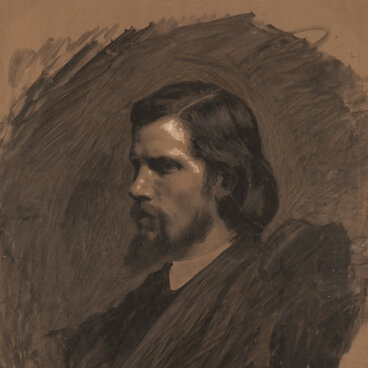The drawing “Jesus with a Child” by Nikolai Alexandrovich Koshelev was donated to the Ostrogozhsk Art Gallery by the artist’s widow Ottilia Yegorovna Kosheleva in 1907. This touching portrait became another one in the collection of images of Christ (drawings and icons) that was partly destroyed during the barbaric bombing of Ostrogozhsk by Nazi Germany in 1942.
Koshelev illustrated the biblical scene about Jesus healing a boy possessed by an evil spirit. This miracle was witnessed by an amazed crowd and Christ’s disciples. The boy freed from an evil spirit is depicted with great sympathy: Christ holds the enfeebled child close to him in a kind and fatherly manner. It seems that Nikolai Koshelev was able to portray the soulful look of Christ not only because of his experience in depicting biblical scenes but also because of his profound faith.
Nikolai Koshelev was born into a peasant family in Penza Governorate. He already showed a penchant for fine arts as a young child, but because of the lack of money, he was only able to pursue his dreams as an artist much later, partly thanks to luck (the help of a local landlady who was a patron of arts) and partly thanks to his indomitable perseverance and hard work.
This drawing by Nikolai Koshelev is one of the numerous studies and sketches he made for painting churches which was his occupation throughout his life. Between 1863 and 1865, Koshelev and Kramskoy worked together on decorating the dome of the Cathedral of Christ the Savior. At the same time, Koshelev joined the St. Petersburg Artel of Artists led by Ivan Kramskoy who once painted a vivid portrait of Koshelev.
In fact, the work on the interiors of the Cathedral of Christ the Savior influenced the fate of Nikolai Koshelev: in 1873, he was awarded the title of an academician of painting, and five years later, he was appointed a professor. With the money he earned, Nikolai Koshelev was able to travel abroad where he finally saw the best works of Western European painting. In Rome, Koshelev created a series of large-scale paintings inspired by biblical stories. These works were exhibited both in Italy and Russia, including St. Petersburg, Gatchina, and Moscow, were highly praised by his colleagues and helped him win the hearts of art lovers.
Koshelev illustrated the biblical scene about Jesus healing a boy possessed by an evil spirit. This miracle was witnessed by an amazed crowd and Christ’s disciples. The boy freed from an evil spirit is depicted with great sympathy: Christ holds the enfeebled child close to him in a kind and fatherly manner. It seems that Nikolai Koshelev was able to portray the soulful look of Christ not only because of his experience in depicting biblical scenes but also because of his profound faith.
Nikolai Koshelev was born into a peasant family in Penza Governorate. He already showed a penchant for fine arts as a young child, but because of the lack of money, he was only able to pursue his dreams as an artist much later, partly thanks to luck (the help of a local landlady who was a patron of arts) and partly thanks to his indomitable perseverance and hard work.
This drawing by Nikolai Koshelev is one of the numerous studies and sketches he made for painting churches which was his occupation throughout his life. Between 1863 and 1865, Koshelev and Kramskoy worked together on decorating the dome of the Cathedral of Christ the Savior. At the same time, Koshelev joined the St. Petersburg Artel of Artists led by Ivan Kramskoy who once painted a vivid portrait of Koshelev.
In fact, the work on the interiors of the Cathedral of Christ the Savior influenced the fate of Nikolai Koshelev: in 1873, he was awarded the title of an academician of painting, and five years later, he was appointed a professor. With the money he earned, Nikolai Koshelev was able to travel abroad where he finally saw the best works of Western European painting. In Rome, Koshelev created a series of large-scale paintings inspired by biblical stories. These works were exhibited both in Italy and Russia, including St. Petersburg, Gatchina, and Moscow, were highly praised by his colleagues and helped him win the hearts of art lovers.





